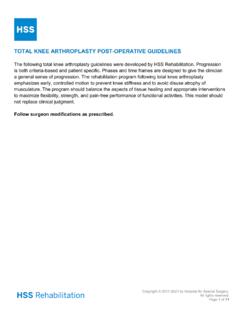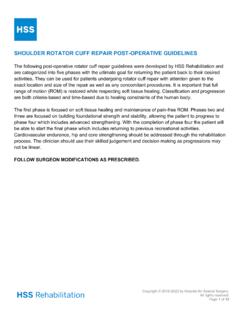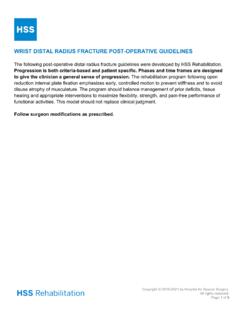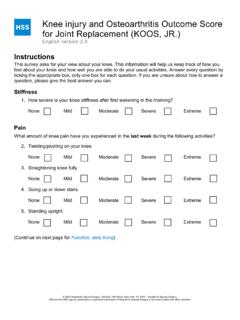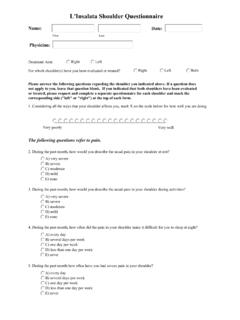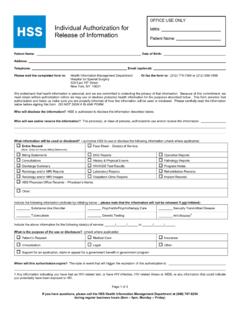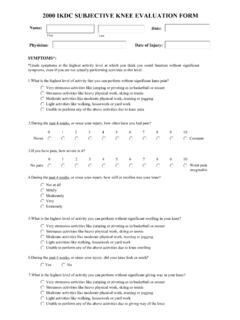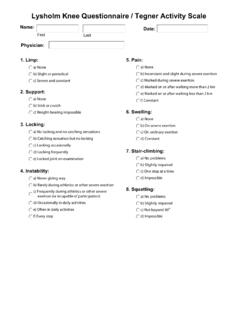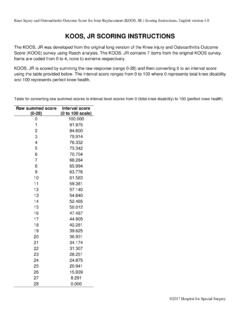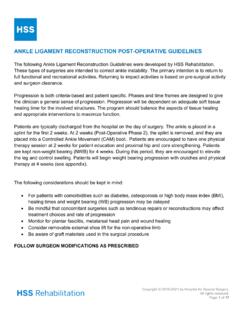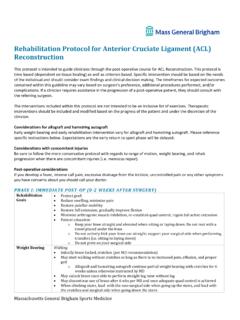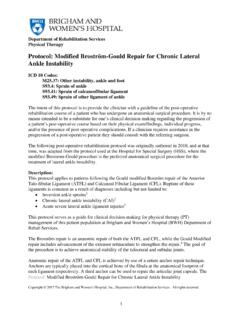Transcription of KNEE ANTERIOR CRUCIATE LIGAMENT (ACL) …
1 Copyright 2019-2020 by Hospital for Special Surgery. All rights reserved. Page 1 of 22 KNEE ANTERIOR CRUCIATE LIGAMENT (ACL) reconstruction post - operative guidelines The following ANTERIOR CRUCIATE LIGAMENT reconstruction (ACLR) guidelines were developed by the HSS Rehabilitation. Progression is both criteria-based and patient specific. Phases and time frames are designed to give the clinician a general sense of progression. Progression through the phases may vary in individuals with concomitant injuries/procedures such as graft choice, donor site, chondral injury, meniscal injury, and LIGAMENT injury. These guidelines are specific to bone-tendon-bone grafts. For hamstring grafts, quadricep tendon grafts, allografts, and concomitant surgeries, see appendix 1. Follow physician modifications as prescribed.
2 Copyright 2019-2020 by Hospital for Special Surgery. All rights reserved. Page 2 of 22 KNEE ANTERIOR CRUCIATE LIGAMENT (ACL) reconstruction post - operative guidelines Pre- operative Phase PRECAUTIONS Avoid pain with ROM and strengthening exercises Modify or minimize activities that increase pain and/or swelling Use appropriate assistive device as needed ASSESSMENT Lower Extremity Functional Scale (LEFS) International Knee Documentation Committee (IKDC) SANE ACL RSI Numeric pain rating scale (NPRS) Swelling Quality of quadriceps contraction Lower extremity (LE) AROM and PROM LE flexibility LE strength Single limb stance (SLS) if appropriate Gait Current activity level/demands on LE TREATMENT RECOMMENDATIONS Patient education o post - operative plan of care o Edema control o Activity modification o Gait training with expected post - operative assistive device o Basic home exercise program (HEP) ankle pumps, quadriceps sets, gluteal sets Knee flexion and extension AAROM Straight leg raises in multiple planes LE flexibility exercises supine calf and hamstring stretches Passive knee extension with towel roll under heel Plantar flexion with elastic band or calf raises Copyright 2019-2020 by Hospital for Special Surgery.
3 All rights reserved. Page 3 of 22 Gait training with appropriate pre- operative assistive device if needed Additional recommendations for patients attending multiple sessions pre-operatively o Edema management o ROM exercises knee flexion AAROM, supine knee extension PROM o LE flexibility exercises o LE progressive resistive exercises o Balance/proprioceptive training o Stationary bike GOALS FOR PRE- operative PHASE Knee PROM: full extension to 120 degrees flexion Minimal to no swelling Active quadriceps contraction with superior patella glide Demonstrates normal gait Able to ascend stairs Able to verbalize/demonstrate post - operative plan of care EMPHASIZE Familiarization with post - operative plan of care Quadriceps contraction Control swelling Knee ROM with focus on extension unless mechanically blocked Copyright 2019-2020 by Hospital for Special Surgery.
4 All rights reserved. Page 4 of 22 KNEE ANTERIOR CRUCIATE LIGAMENT (ACL) reconstruction post - operative guidelines Acute Care (Ambulatory Surgery): Day of Surgery PRECAUTIONS Avoid prolonged sitting, standing, and walking Avoid advancing weight bearing (WB) too quickly which may prolong recovery Avoid pain with walking and exercises Avoid painful activities Avoid putting heat on knee Avoid weightbearing without brace Avoid ambulating without crutches Do not put a pillow under the operated knee- keep extended when resting and sleeping ASSESSMENT Mental status: Alert and Oriented x3 NPRS Wound status Swelling P/AAROM of knee post -anesthesia sensory motor screening Functional status including ability to manage brace TREATMENT RECOMMENDATIONS Transfer training Gait training WBAT with assistive device on level surfaces and stairs Patient education: o Edema management o Activity modification o Brace management o Initiate and emphasize importance of HEP Quadriceps sets, gluteal sets, ankle pumps, Seated knee AAROM Straight leg raise with brace locked in extension, if able Passive knee extension with towel roll under heel Copyright 2019-2020 by Hospital for Special Surgery.
5 All rights reserved. Page 5 of 22 CRITERIA FOR DISCHARGE Independent ambulation with appropriate assistive device on level surfaces and stairs Independent brace management Independent with transfers Independent with HEP EMPHASIZE Control swelling Quadriceps contraction Independent transfers Gait training with appropriate assistive device P/AAROM (focus on extension) Appropriate balance of activity and rest Copyright 2019-2020 by Hospital for Special Surgery. All rights reserved. Page 6 of 22 KNEE ANTERIOR CRUCIATE LIGAMENT (ACL) reconstruction post - operative guidelines post - operative Phase 1: Weeks 0-2 PRECAUTIONS Do not put a pillow under the operated knee for comfort when elevating LE Avoid active knee extension 40 0 Avoid ambulation without brace locked at 0 Avoid heat application Avoid prolonged standing/walking Avoid ambulating without crutches ASSESSMENT Lower Extremity Functional Scale (LEFS) International Knee Documentation Committee (IKDC) SANE ACL RSI NPRS Swelling Girth measurements Neurovascular assessment Wound status Patellar mobility Quality of quadriceps contraction LE AROM and PROM LE flexibility, where appropriate LE strength, where appropriate SLR in supine Single leg stance, when appropriate Gait Current activity level Copyright 2019-2020 by Hospital for Special Surgery.
6 All rights reserved. Page 7 of 22 TREATMENT RECOMMENDATIONS Passive knee extension with towel under heel Quadriceps re-education: quadriceps sets with towel under knee with neuromuscular electric stimulation (NMES) or biofeedback Patellar mobilization AROM knee flexion to tolerance, AAROM knee extension to 0 Straight leg raises (SLR) in all planes o With brace locked at 0 in supine Hip progressive resistive exercises Calf strengthening o Unilateral elastic band bilateral calf raises Leg press bilaterally in 80 -5 arc if knee flexion ROM > 90 Initiate flexibility exercises Proprioception board/balance system (bilateral WB) Stationary bicycle: o Short (90mm) crank ergometry (requires knee flexion > 85 ) o Standard crank for ROM and/or cycle (requires 115 knee flexion) Upper extremity ergometry, as tolerated Gait training with progressive WB o Gradual progression with brace locked at 0 with crutches Edema management, cryotherapy (no submersion), elevation, gentle edema mobilization avoiding incision Progressive home exercise program CRITERIA FOR ADVANCEMENT Ability to SLR without quadriceps lag or pain Knee ROM 0 -90 Pain and swelling controlled EMPHASIZE Patellar mobility Full PROM knee extension Improving quadriceps contraction Controlling pain and swelling Compliance with HEP and precautions Copyright 2019-2020 by Hospital for Special Surgery.
7 All rights reserved. Page 8 of 22 KNEE ANTERIOR CRUCIATE LIGAMENT (ACL) reconstruction post - operative guidelines post - operative Phase 2: Weeks 3-6 PRECAUTIONS Do not put a pillow under the operated knee- keep extended when resting and sleeping Avoid pain with exercises, standing, walking and other activities o Monitor tolerance to load, frequency, intensity and duration Avoid premature discharge of assistive device - should be used until gait is normalized Avoid advancing weight bearing too quickly which may prolong recovery Avoid active knee extension 40 0 Avoid heat application Avoid prolonged standing/walking Avoid ascending/descending stairs reciprocally until adequate quadriceps control & lower extremity alignment ASSESSMENT LEFS IKDC SANE ACL RSI NPRS Swelling Girth measurements Neurovascular assessment Wound status Patellar mobility Quality of quadriceps contraction LE AROM and PROM LE flexibility, where appropriate LE strength, where appropriate SLR in supine Single leg stance, when appropriate Gait Current activity level Copyright 2019-2020 by Hospital for Special Surgery.
8 All rights reserved. Page 9 of 22 TREATMENT RECOMMENDATIONS Passive knee extension with towel under heel Quadriceps re-education: quadriceps sets with towel under knee with neuromuscular electric stimulation (NMES) or biofeedback Patellar mobilization AROM knee flexion to tolerance o Progression from seated to standing (wall slides) to bike ROM AAROM knee extension to 0 Straight leg raises (SLR) PRE s in all planes o With brace locked at 0 in supine until no extension lag demonstrated o Brace may be removed in other planes Leg press bilaterally in 80 -5 arc if knee flexion ROM > 90 o Progression from bilaterally to 2 up/1 down, to unilateral Functional strengthening o Mini squats progressing to 0 -60 , initiating movement with hips o Forward step-up progression starting with 2 -4 Terminal knee extension in weight bearing Consider blood flow restriction (BFR)
9 Program with FDA approved device if patient cleared by surgeon and qualified therapist available Hip-gluteal progressive resistive exercises o May introduce Romanian Dead Lift (RDL) toward end of phase Hamstring strengthening (unless hamstring autograft) Calf strengthening o Progression from bilateral to unilateral calf raises Flexibility exercises Proprioception board/balance system o Progression from bilateral to unilateral weight bearing o Once single leg stance achieved with good alignment and control, progress from stable to unstable surfaces Stationary bicycle o Standard crank for ROM and/or cycling (requires 115 knee flexion) Upper extremity ergometry, as tolerated Gait training WBAT- may still have brace locked at 0 and crutches (see appendix 2) Edema management, cryotherapy (no submersion until incision adequately healed), elevation, gentle edema mobilization avoiding incision Progressive home exercise program Patient education regarding monitoring of response to increase in activity level and weightbearing Copyright 2019-2020 by Hospital for Special Surgery.
10 All rights reserved. Page 10 of 22 CRITERIA FOR ADVANCEMENT Knee ROM 0 -130 Good patellar mobility Minimal swelling SLS FWB without pain Non-antalgic gait Ascend 6 stairs with good control without pain EMPHASIZE Knee ROM Patella mobility Quadriceps contraction Normalizing gait pattern Activity level to match response and ability Copyright 2019-2020 by Hospital for Special Surgery. All rights reserved. Page 11 of 22 KNEE ANTERIOR CRUCIATE LIGAMENT (ACL) reconstruction post - operative guidelines post - operative Phase 3: Weeks 7- 12 PRECAUTIONS Do not put a pillow under the operated knee- keep extended when resting and sleeping Avoid pain with exercises, standing, walking and other activities o Monitor tolerance to load, frequency, intensity and duration o Avoid too much too soon Avoid active knee extension 40 0 until post -op week 12 ASSESSMENT LEFS IKDC SANE ACL RSI NPRS Swelling Girth measurements Neurovascular assessment Wound/scar status Patellar mobility Quality of quadriceps contraction LE AROM and PROM LE flexibility, where appropriate LE strength, where appropriate SLR in supine Functional assessment, single leg stance, step ups/downs, squat, gait Balance testing, Star Excursion Test.

